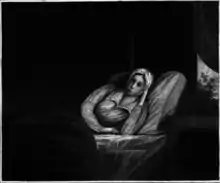Cynthia Taggart
Cynthia Taggart (1801 - 1849) was a 19th-century American poet. A chronic invalid, she was the victim of unceasing pain, from her early infancy, during the period of her adolescence, and through the duration of her life.[1] Physical anguish was a repetitive theme in Taggart's poems.[2]
Cynthia Taggart | |
|---|---|
 | |
| Born | 1801 near Newport, Rhode Island, U.S. |
| Died | 1849 |
| Occupation | poet |
| Language | English |
| Nationality | American |
| Notable works | Poems |
Early years and education
Cynthia Taggart was born in 1801,[3][4] or ca. 1804, in a cottage about 6 miles (9.7 km) from Newport, Rhode Island.[1][5] She was the daughter of a soldier, whose property was destroyed during the American Revolution, and who died in old age and poverty at the family home.[1]
Though she had few opportunities of learning, she did receive religious training.[5] Taggart's education was very slight, and until sickness deprived her of all other occupation opportunities, about the year 1822, when she was 19 years of age, she appeared never to have thought of literary composition.[1]
Career
.png.webp)
Taggart and a widowed sister, who was also an invalid, lived in their paternal home by the seashore.[1] She enumerated among her greatest sufferings, an inability to sleep. For many years, she was unable to sleep, except when taking anodynes. It was during these long night, when she was in severe pain, that she developed her poetry.[5]
Her poems were collected and published in 1834, with an autobiography, describing her hopeless and helpless condition. The poems were published by some friends to avert poverty and dependence from Taggart's life.[6] The work passed through three editions, two in 1834 and one in 1848.[5][1]
Personal life
Rev. James C. Richmond wrote Taggart's biography in The Rhode Island Cottage.[1] Taggart died in 1849.[5]
References
- Griswold 1852, p. 133.
- "Cynthia Taggart". The Library Company of Philadelphia. Retrieved 2 October 2017.
- Funk & Wagnalls 1894, p. 647.
- Duzee 1902, p. 112.
- Hale 1853, p. 425.
- Richmond 1849, p. 5.
Bibliography
 This article incorporates text from a publication now in the public domain: Duzee, Edward P. Van (1902). Catalogue of Poetry in the English Language: In the Grosvenor Library, Buffalo, N.Y. (Public domain ed.). Grosvenor Library (London, England).CS1 maint: ref=harv (link)
This article incorporates text from a publication now in the public domain: Duzee, Edward P. Van (1902). Catalogue of Poetry in the English Language: In the Grosvenor Library, Buffalo, N.Y. (Public domain ed.). Grosvenor Library (London, England).CS1 maint: ref=harv (link)  This article incorporates text from a publication now in the public domain: Funk & Wagnalls (1894). The Cyclopaedia of Practical Quotations: English and Latin; with an Appendix Containing Proverbs from the Latin and Modern Foreign Languages; Law and Ecclesiiastical Terms and Significations; Names, Dates and Nationality of Quoted Authors, Etc., with Copious Indexes (Public domain ed.). Funk & Wagnalls.CS1 maint: ref=harv (link)
This article incorporates text from a publication now in the public domain: Funk & Wagnalls (1894). The Cyclopaedia of Practical Quotations: English and Latin; with an Appendix Containing Proverbs from the Latin and Modern Foreign Languages; Law and Ecclesiiastical Terms and Significations; Names, Dates and Nationality of Quoted Authors, Etc., with Copious Indexes (Public domain ed.). Funk & Wagnalls.CS1 maint: ref=harv (link)  This article incorporates text from a publication now in the public domain: Griswold, Rufus Wilmot (1852). The Female Poets of America (Public domain ed.). H.C. Baird.CS1 maint: ref=harv (link)
This article incorporates text from a publication now in the public domain: Griswold, Rufus Wilmot (1852). The Female Poets of America (Public domain ed.). H.C. Baird.CS1 maint: ref=harv (link)  This article incorporates text from a publication now in the public domain: Hale, Sarah Josepha Buell (1853). Woman's Record; or, sketches of all distinguished women from the Creation to A.D. 1854 ... Second edition (Public domain ed.). Sampson Low, Son&Company.CS1 maint: ref=harv (link)
This article incorporates text from a publication now in the public domain: Hale, Sarah Josepha Buell (1853). Woman's Record; or, sketches of all distinguished women from the Creation to A.D. 1854 ... Second edition (Public domain ed.). Sampson Low, Son&Company.CS1 maint: ref=harv (link)  This article incorporates text from a publication now in the public domain: Richmond, James Cook (1849). The Rhode Island Cottage; Or, a Gift for the Children of Sorrow ... First English, from Second American Edition (Public domain ed.). p. 5.CS1 maint: ref=harv (link)
This article incorporates text from a publication now in the public domain: Richmond, James Cook (1849). The Rhode Island Cottage; Or, a Gift for the Children of Sorrow ... First English, from Second American Edition (Public domain ed.). p. 5.CS1 maint: ref=harv (link)
External links
- Works by or about Cynthia Taggart at Internet Archive
- Biography, The Rhode Island Cottage by James Cook Richmond